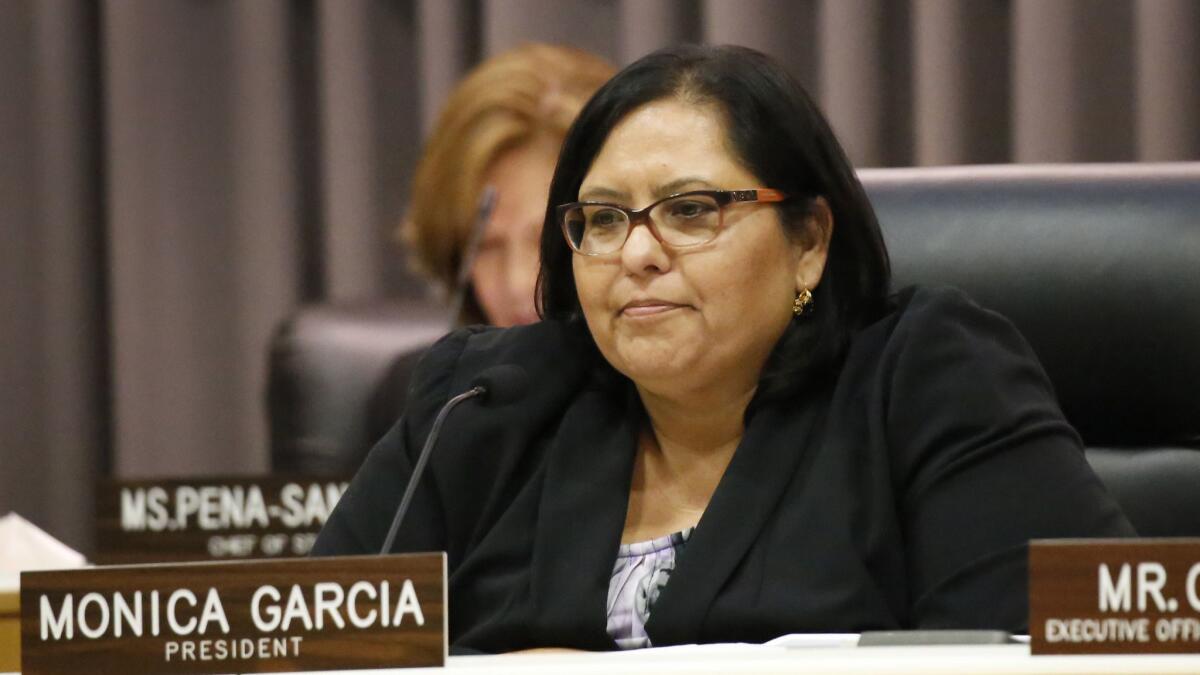School board approves a new formula for funding high-need schools

L.A. schools will soon get more money if they are located in neighborhoods with such problems as high levels of gun violence and asthma.
The Los Angeles Board of Education voted unanimously Tuesday to adopt a new formula to determine how to dole out some funding to schools, based not only on the characteristics of the student populations but on the traumas that affect the communities around campuses.
The new formula will be applied to $25 million in funding next fiscal year and about $263 million annually in future years — a small part of the district’s $7.5-billion annual budget.
Beyond a base amount of funding for each student, the Los Angeles Unified School District receives about $1 billion a year in extra funding through a recent state funding formula aimed at providing more help to students who are low-income, English learners or foster youth.
Until now, L.A. Unified has doled out additional money to schools primarily based on the number of high-need students they have. But some argued that this formula oversimplified complex issues and that factors such as community health problems and violence should also be considered.
Board President Monica Garcia’s resolution uses elements of the “student need index,” developed about four years ago by the Equity Alliance for L.A.’s Kids, a coalition of community groups and civil rights organizations including the Advancement Project California, Community Coalition and InnerCity Struggle. Among the factors the district’s index takes into account are dropout and chronic absenteeism rates, and grades that would qualify students for admission to Cal State universities.
Although the text of the resolution referenced the index and mentioned the factors that would be taken into account, it did not specify the exact formula that would be applied.
For 2018-19, the $25 million could be split between up to 228 schools, with $24,000 to $313,000 for each school, said Pedro Salcido, the district’s director of finance policy.
The board specified that the superintendent must form a “working group” to finalize the index and formula. That group also will be asked to evaluate the effects of the funding on schools.
The resolution will take full effect in the 2019-20 budget. For the coming year, the district will apply the new index to $25 million in reallocated funding from the district’s future budgets, such as unused money from programs that are scheduled to end soon, said L.A. Unified Chief Financial Officer Scott Price.
Schools are in the process of planning budgets and making hiring decisions for next year. Approving the new formula now gives school administrators the opportunity to figure in the new funding and to include parents in the process, said Interim Supt. Vivian Ekchian.
The resolution passed unanimously to cheers from students and activists in the board room, though some board members expressed initial reluctance, saying parents did not have enough time to review the changes or provide input.
After the vote, Garcia said the discussion is one the district has been having for years, and that parents are involved in the advocacy groups that pushed for the resolution.
Resolutions like this are supposed to be introduced to the school board in one meeting, then voted on in a second one at a later time, to give the public time to get informed and respond. The “initial announcement” of this resolution was on the agenda for the school board meeting at 1 p.m. Tuesday, and the plan was to vote at a later meeting in May. But on Monday afternoon, the district posted a “special meeting” notice for 4:45 p.m. Tuesday — with one item on the agenda: “Equity Is Justice 2.0: Moving toward a New Direction.”
Advocates said they were happy that the district was shifting its thinking. Schools will be able to use the funding to combat the effects of trauma on students, with academic programs and mental health support, said Aurea Montes-Rodriguez, executive vice president of the South L.A.-based advocacy group Community Coalition.
Dozens of students rallied outside prior to the meeting, before demanding funding from the board members inside. One of those young activists was Edna Chavez of Manual Arts High School, who spoke last month during the March for Our Lives in Washington about losing her brother to gun violence.
“Aren’t the youth the future? So why aren’t we getting those resources? Is it because of our ZIP Code? Is it because of the amount of melanin in our skin?” she asked the board before the vote.
After the vote, Edna was ecstatic. But she said there was more work to be done.
“We’re going to continue fighting,” she said, “for more and more and more.”
Times staff reporter Howard Blume contributed to this story.
Reach Sonali Kohli at [email protected] or on Twitter @Sonali_Kohli.
UPDATES:
April 11, 3:30 p.m.: This article was updated with a revised estimate for school allocations.
This article was originally published April 10 at 9:15 p.m.
More to Read
Sign up for Essential California
The most important California stories and recommendations in your inbox every morning.
You may occasionally receive promotional content from the Los Angeles Times.











